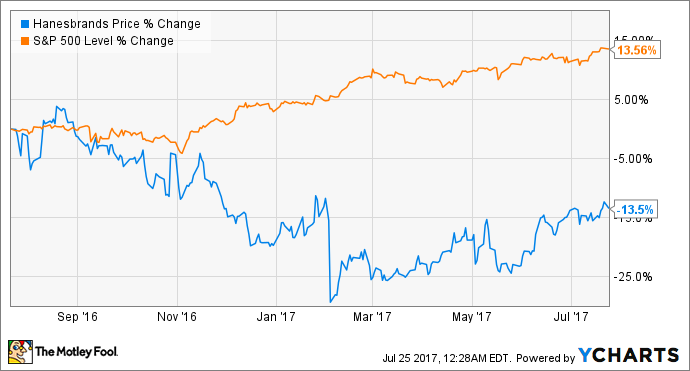Paying a yield of 2.6%, investors seeking dividend stocks may find Hanesbrands (HBI 0.64%) an attractive option. The clothing company owns multiple brands including its namesake Hanes, Playtex, and Jockey. The company has increased its payout every year since 2013 and its most recent payout increased more than 36% over the prior year.

Image source: Getty Images
A consistently growing dividend is a strong signal of business strength but investors should be wary if yields begin to creep up. At first glance, Hanes's dividend yield of 2.6% does not appear to be a concern. It's not much higher than the S&P 500 yield of 1.9%. However, the yield has increased 43% over the past year and although this is generally positive, the reasoning behind the increase can be a red flag.
Measured as dividend per share divided by price per share, dividend yields can go up with a combination of two factors -- an increasing payout and/or a declining share price. With consistent annual dividend bumps, Hanesbrands has been increasing its payout. However, its stock price has also taken a hit over the last year, causing its yield to increase.
Although Hanes stock has recovered from its 52-week low reached in February, it's still down 13.5% for the year, trailing the S&P 500 by a whopping 27%. When a stock is down double-digits during a bull market, there should be cause for concern. Weak business results can cause a halt in future dividend increases or even worse, an eventual dividend cut. Therefore, Hanesbrands investors seeking yield should take a deeper look at the numbers to see if the company's dividend is sustainable.
Why the stock price drop?
It's no secret the retail industry is struggling. Brokerage firm Credit Suisse reported 2,056 stores closed in 2016 and indicated more than 8,600 brick-and-mortar stores will close in 2017. To put the latter number in perspective, more stores will close in 2017 than the worst year on record when over 6,000 stores were closed during the great recession in 2008.
Hanesbrands is not immune to the retail struggles. Hanes's largest customer, Wal-Mart (WMT -0.32%), accounted for 20% of its net sales in 2016. Last year, the retail giant announced it will close 269 stores. As a result of Wal-Mart and the industry struggles, with the exception of international, 2016 year-over-year sales dropped in each of Hanes's operating segments. Innerwear sales, its largest contributor to revenue, fell 2.7%.
|
Operating segment |
2016 |
2015 |
Change (%) |
|---|---|---|---|
|
Innerwear |
$2,609,754 |
$2,680,981 |
-2.7% |
|
Activewear |
$1,570,972 |
$1,576,724 |
-0.4% |
|
International |
$1,531,913 |
$1,132,637 |
35.2% |
|
Total net sales |
$6,028,199 |
$5,731,549 |
5.2% |
Data source: Company filings
The weak results spilled over into profits as Hanes has failed to beat Wall Street earnings estimates in 4 of the past 6 quarters.
There is also concern about Hanes's recent acquisitions and its accumulation of debt to help for them. Last year, the company spent $964 million on acquisitions while adding nearly $1.3 billion in long-term debt on its balance sheet. Its debt to equity ratio today sits at 432%.
Dividend analysis
A combination of a declining business along with increasing debt can be burdensome on a company's financials. If it begins to struggle making interest payments, a dividend cut will be likely. Let's see if Hanes is in jeopardy.
Hanes's trailing-twelve-month (TTM) dividend payout ratio, the total dividend paid to shareholders relative to its net income, came in at a healthy 35%. The company's payout ratio actually came in less than two other popular apparel makers, Gap Inc. and V.F. Corp payout 53% and 64% of their earnings as dividends respectively.
The dividend payout ratio is a fine metric to look at but one flaw is that it compares dividends paid, a cash transaction, to earnings, an accounting metric. A more accurate measure to validate the safety of a dividend would be to compare the dividends paid to a company's free cash flow, which is the amount of operating cash available after investing in its business. A quick look at this measure shows that Hanesbrands may have some wiggle room to increase its dividend further.
|
Metric (TTM) |
FY 2016 Amount |
|---|---|
|
Operating cash flow |
$605,607 |
|
Capital expenditures |
($83,399) |
|
Free cash flow |
$522,208 |
|
Dividends paid |
$167,375 |
|
Dividend-to-FCF-ratio |
32% |
All numbers in thousands. Data source: Annual filings.
Hanesbrands still has some dirty laundry
Despite a relatively low dividend payout ratio, Hanesbrands investors still have reasons to be concerned. Between 2014 and 2016, the company spent over $1.5 billion on acquisitions. Investors shouldn't expect the buying spree to be complete either. Hanesbrands has communicated to investors that acquisitions remain a key component of its long-term growth strategy.
Another concern is Hanes's underfunded pension plan. As of the end of its most recent quarter ending in April, Hanesbrands had $375 million in pension liabilities in addition to its $3.7 billion in debt. At some point, Hanesbrands will have to make this liability up.
Although Hanesbrands dividend appears to be sustainable over the near-term, investors should keep a close eye on the company to make sure it can meet all its obligations over a longer period. Between maintaining annual dividend increases, meeting long-term obligations to its employees and bondholders, and continuing to make acquisitions, Hanesbrands must be on top of its game. Given its recent business struggles, I'm not sold that the dividend can be sustained unless it either turns things around or slows down the buying spree.






